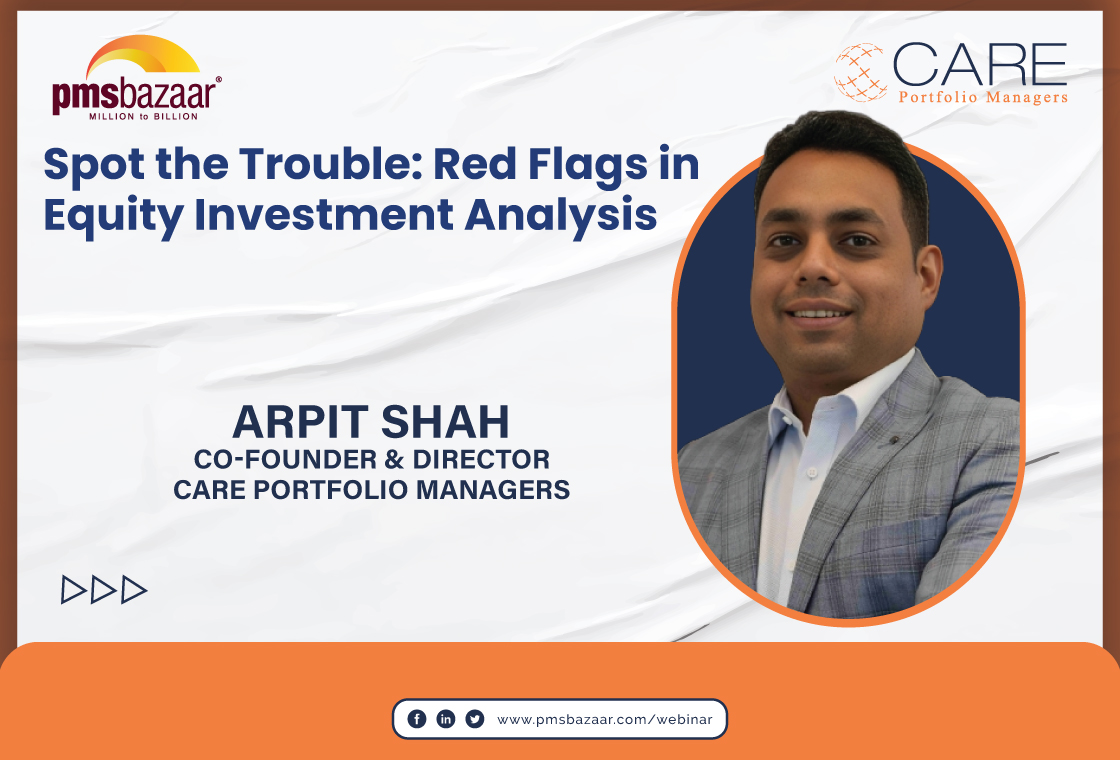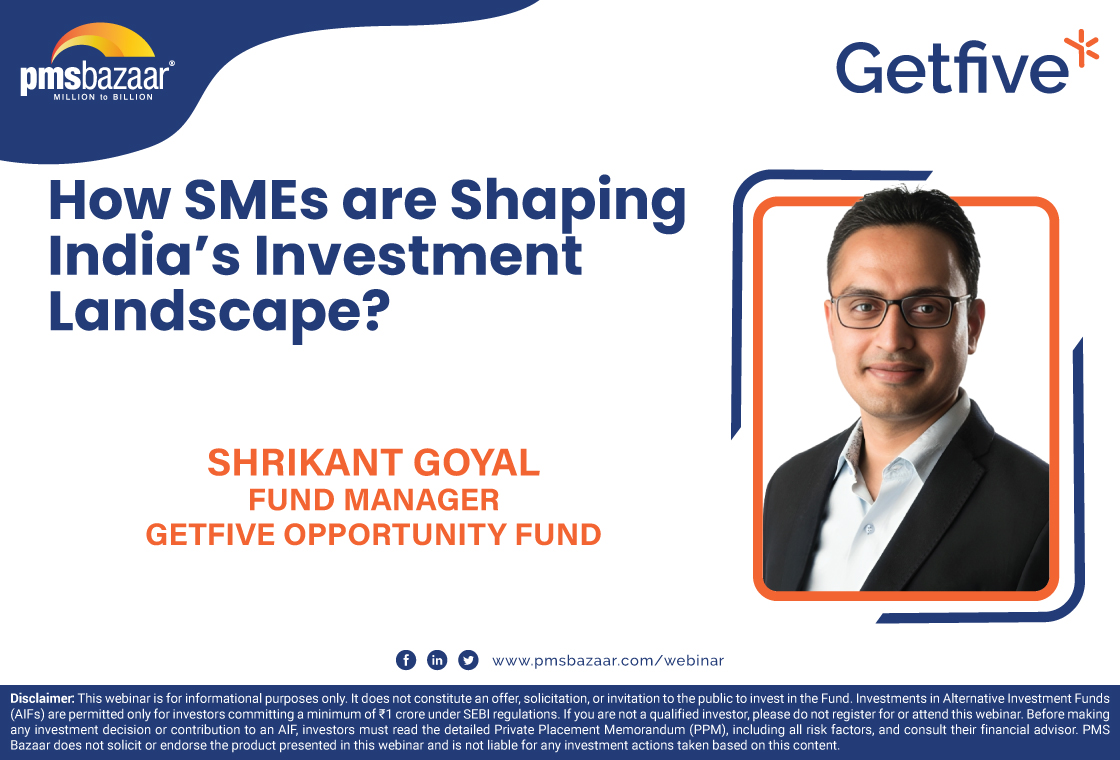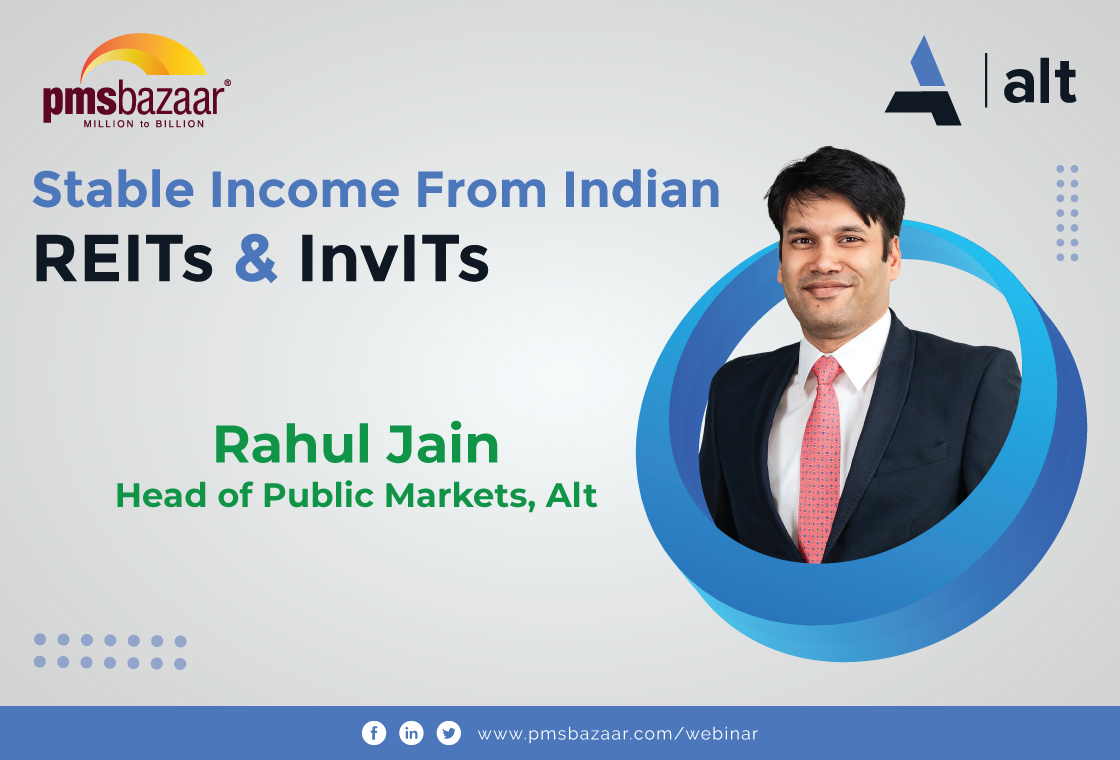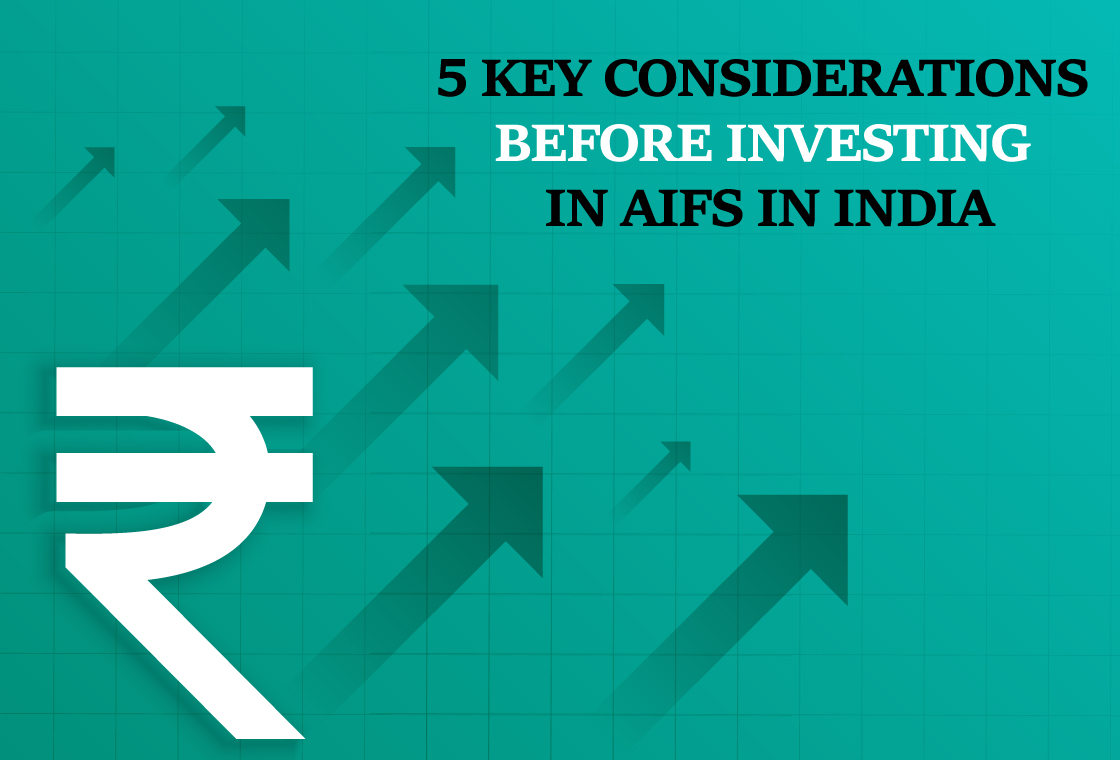Alternative Investment Funds or AIFs have become a buzzword for rich investors, of late. To spread awareness about this interesting investment product, Emkay Investment Managers and PMS Bazaar held a special webinar 'Emkay Dhan ki Baat - a 360° look at AIF products in India'. The mission of the webinar was to let investors learn the A to Z of AIFs from the experts.

The distinguished speakers of the panel discussion were Mr. Sandeep Parekh - Managing Partner, Finsec Law Advisors, Mr. Somnath Mukherjee - Managing Partner & CIO, ASK Wealth Advisors, Mr. Subramaniam Krishnan - Partner Private Equity & Financial Services - Tax & Regulatory Services, EY, Mr. Vikaas M Sachdeva - CEO, Emkay Investment Managers and Mr. Sachin Shah - Fund Manager, Emkay Investment Managers.
For the uninitiated, Alternative Investment Fund or AIF means any fund established or incorporated in India which is a privately pooled investment vehicle that collects funds from sophisticated investors for investing them in accordance with a defined investment policy, for the benefit of its investors.
AIF does not include funds covered under the SEBI (Mutual Funds) Regulations, 1996, SEBI (Collective Investment Schemes) Regulations, 1999 or any other regulations of the Board to regulate fund management activities.
There are broadly 3 categories of AIFs: Category 1, 2 and 3.
The webinar began with a discussion on Category 3 AIFs.
Explaining USPs
According to ASK Wealth's Somnath, Cat 3 AIF is suited for 2 types of investment approaches. One is long short including strategies that involve derivatives, leverage exposure. Do note that this is the only legal structure available in India to offer these strategies. Second is an alternative to PMS as customized and concentrated boutique investment (less documentation, less operational challenges compared to setting up a PMS account). AIF Category 3 provides a neater and a more user-friendly and structured digital experience. This is particularly true for HNIs.
When quizzed by Sachin on flexibility, Somath said Category 3 AIF does afford itself flexibility in terms of structure. One (fund manager) can lower the beta and up the alpha. Part of the reason why MFs, for instance, struggle to generate alpha is fund size and the guard rails that have been put (stock/sector limits). This is in line with the purpose to up investor protection norms for lower-ticket investors such as in MFs.
According to Somnath, Category 3 AIFs have the ability to use derivatives and take leverage while using derivatives. This offers a singularly interesting set of possibilities in terms of reducing risks in portfolios.
In terms of investor profile, Category 3 AIFs are best for investors looking at a slightly higher risk asset class. This requires investors who understand technicalities, and who are open to riding out drawdowns. Simply put, Category 3 AIFs are ideal for sophisticated investors. Somnath, however, emphasised that while ticket size (Rs 1 crore for AIFs) is a straightforward proxy for assessing investor sophistication, it is not necessarily the only factor to ascertain product suitability.
Vikaas asked Somnath for his views on the general perception that AIFs take more risk. Also, one viewer had asked whether AIFs being riskier amplifies risk inherent in mid and smallcap strategies and if so, how one hedges this. Responding to the questions, Somnath said that AIFs do not necessarily raise risk, but it actually depends on the underlying strategies. "Category 3 AIF is a vehicle. It is very important to have investors who understand the nuance. A strategy with style bias towards midcaps, high churn will naturally be more risky," Somnath said.
Due diligence, regulations
Continuing on Category 3 AIFs, the webinar next gravitated towards due diligence. Somnath pointed out that understanding past track record, what AIF managers have done in the past, how analogous is the current strategy to what they have done in the past are very important for investors. "A long-only manager offering a long short strategy can happen. In this case, investors should understand what incremental expertise they own, to offer a long short strategy. Investors should find out what part of the previous expertise is relevant to the strategy offered today. Also, higher the skin in the game, the better it is," he added.
Talking about the regulatory landscape, Sandeep of Finsec Law mentioned that till regulations came in a few years ago, there were hybrid sort of regulations. "Taxation was a major problem untill 2-3 years ago and then the Budget announced relaxation in terms of taxes. Category 3 AIFs didn't pick up because of the tax issue...Today, the industry has invested Rs 2 lakh crore. So, things have changed," he said.
On AIFs being allowed to invest in other AIFs, Sandeep said that this is good for diversification. For instance, a real estate AIF is better at handling realty and AIF managers can focus on their own area. So, AIFs investing in other AIFs makes sense both in terms of specialisation and diversification.
Commenting on the documentation involved, Sandeep said AIF investor documents are overall good for sophisticated investors. "If you are investing Rs 1 crore, the regulatory premise is that if you can invest Rs 1 crore, one is expected to be able to take care of themselves," he noted.
Taxation clarity
Subramaniam Krishnan of EY said that while Category 3 AIFs represented Rs 50,000 crore of commitments raised, it is unfortunate that it still doesn't have a formal tax code. Ironically, there is a tax code for every other vehicle that SEBI regulates, but not one for Category 3 AIFs. Today, 99% of such AIFs are formed as trusts. "If we talk about a long-only kind of fund that buys and holds equity shares, they potentially face capital gain tax rates at higher surcharge rates. This works out to be 10+15+4% (29%) for LTCG," Subramaniam said.
However, the challenge is in the ShortTermGain. "Whether STG is a capital gain or a trading profit - controversy exists around it. For a long only fund where it is clear that the intention of the fund manager at the point of time of making the investment was to hold a security with a 12+ month holding horizon, any opportunistic sale leading to short term gain before the 12+ month tenure does not itself mean that the short term gain will be taxed at the maximum tax rate of 30% plus surcharge." Subramaniam noted. By and large, most funds that have predominantly long-term gains (albeit some short-term gains do happen), have been successfully able to contend that STG should be taxed at 15% (same as STCG rates for equity shares). This equally applies to open-ended and close-ended category 3 AIFs. Do note that LTCG is 11-12% (at maximum) in the current scheme of things.
Subramaniam emphasised that in India, the legal system has inherited a substance oriented law and not a rule based law.
Category 1 and 2 AIFs
The panel also went on to discuss Cat. 1 and 2 AIFs, that again are suitable for sophisticated investors.
According to Sandeep of Finsec Law, “The structures for Cat. 1 and 2 are set up for investing in early stage companies and we have seen a significant amount of ramp-up in cheque sizes for investments. Cat. 1 AIF is the right vehicle for investing in early stage companies”.
The chief difference between Category 1, 2 and 3 AIFs is the skin in the game -(STIG) for Category 3 is 5% or Rs 10 crore, whichever is lower. In Category 1 and 2, STIG is half that number.
Originally Category 1 AIF was for socially beneficial investing, but for most purposes, 1 and 2 are very similar.
Do note that Category 3 AIF can be either open or close-ended in structure, while Category 1 and 2 AIFs are mandatorily close-ended.
Simply put, Category 1 AIFs are socially beneficial. Category 2 is domestic private equity, while Category 3 AIFs are domestic hedge funds.
Explaining the taxation part, Subramaniam of EY said that for Category 1 and 2 the tax framework is clear and straightforward. "The funds are essentially pass-through and there is no tax paid at the fund level at all. All of the income that is earned at the fund level is treated as if the investor had made those underlying investments or earned those incomes or gains at their own hands. So, whatever income is earned by the investor is taxed in the year when the fund earns it. Of course, funds have a withholding tax on the tax that is payable and an investor can get credit on it," the tax expert opined.
SEBI accredited investor framework
The newly announced accredited investor framework was discussed at great lengths in the webinar.
According to Sandeep of Finsec Law, AIFs can be sold to anyone in the sense that SEBI has presumed that anybody who has Rs 1 crore to invest is automatically rich and very sophisticated. There is no regulatory requirement on suitability, financial literacy etc.
However, SEBI’s new rules say that to apply to be an accredited investor, an individual needs to meet one of three conditions. One, you must have an annual income of over Rs 2 crore. Two, you can have a net worth of at least Rs 7.5 crore - of which at least Rs 3.75 crore is in the form of financial assets. Three, you can have an annual income of Rs 1 crore and a net worth of Rs 5 crore, out of which at least half is in financial assets.
To calculate this net worth, your primary residence or the home you live in, will be excluded from the calculation. Your other real estate assets will be considered. If you jointly hold investments with your parents or children, at least one of you should independently meet these conditions. You and your spouse can, however, combine your incomes/net worth to meet this bar. You can apply for accreditation for one year or two years. If you need the certificate to be valid for one year, you need to have met the above conditions for the last financial year. To get two-year validity, you should have met these conditions continuously for the last three years. "The benefit of being an accredited investor is that you can invest in AIFs. with less than Rs 1 crore investment," Sandeep said.
According to Ask Wealth's Somnath, the impact of accredited investors on the AIF industry can be gauged later. "It is still early days on the Accredited Investor (AI) and Sophisticated Investor (SI) framework front in india. We are taking the first steps...The benefits are still a work in the progress," he noted.
A full 25 minutes were devoted to answering questions from webinar attendees who had queries on AIF strategies, taxes, investment approaches, returns, IFSC AIF benefits etc. The speakers answered the key queries in a detailed manner.
If you missed the opportunity to listen to the experts directly, you can relive the entire session through the appended link below:
For more information, please contact info@pmsbazaar.com
Recent Blogs
.jpg)
Passively Active Investing — A Modern Investor’s Lens on ETF-Based PMS
PMS Bazaar recently organized a webinar titled “Passively Active Investing — A Modern Investor’s Lens on ETF-Based PMS,” which featured Mr. Karan Bhatia, Co-Founder and Co-Fund Manager , Pricebridge Honeycomb ETF PMs. This blog covers the important points shared in this insightful webinar.

Spot the Trouble: Red Flags in Equity Investment Analysis
PMS Bazaar recently organized a webinar titled “Spot the Trouble: Red Flags in Equity Investment Analysis,” which featured Mr. Arpit Shah, Co-Founder & Director, Care Portfolio Managers. This blog covers the important points shared in this insightful webinar.

Long-Only AIFs Rebound Sharply in October; Long-Short Strategies Lag Despite Lower Volatility
106 long-only AIFs averaged 3.68% vs 32 long-short AIFs at 2.7%; only 24–31% of funds beat key indices

Markets log strongest monthly gains in 7 months; PMS performance turns near-uniform in October
Nifty 50 TRI gained 4.62%, BSE 500 TRI rose 4.27%; 415 of 427 equity PMSes ended positive

How SMEs are Shaping India’s Investment Landscape?
PMS Bazaar recently organized a webinar titled “How SMEs are Shaping India’s Investment Landscape?” which featured Mr. Shrikant Goyal, Fund Manager, GetFive Opportunity Fund.

Stable Income from Indian REITs and InvITs
PMS Bazaar recently organized a webinar titled “Stable Income from Indian REITs and InvITs,” which featured Mr. Rahul Jain, Head of Public Markets, Alt.

5 Key Considerations Before Investing in AIFs in India
Alternative Investment Funds (AIFs) have emerged as a compelling option for sophisticated investors seeking diversification and potentially superior returns. But venturing into AIFs requires a clear understanding of their unique characteristics that go beyond simply knowing what they are and their categories.

How AIF can help in diversification?
Traditionally, Indian investors have relied on a mix of stocks and bonds to build their wealth. While this approach offers diversification, it can still leave your portfolio vulnerable to market fluctuations. Enter Alternative Investment Funds (AIFs), a dynamic asset class gaining traction for its ability to unlock diversification beyond the realm of conventional options.

